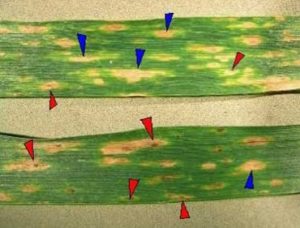by Dr. Clark Neely, Statewide Small Grains Extension Specialist, Texas A&M AgriLife Extension;
Dr. Jake Mowrer, Statewide Soil Fertility Extension Specialist, Texas A&M AgriLife Extension
Without fail, every spring there are questions about yellowing or flecking in wheat across Texas, particularly in Central and South Texas. The first thing that comes to mind is rust. In many cases that is true; however, there have been several instances where rust was not an obvious culprit. Other candidates that come to mind were fungal pathogens such as septoria, tan spot, or powdery mildew or even viruses such as barley yellow dwarf and the rare occurrence of wheat streak mosaic virus in the Blacklands. In some of these cases where leaf tissue samples have been sent off to the plant disease diagnostic lab, samples come back clean of any obvious infection.
Nutrient deficiency is the next thought that might cross your mind. Yet, some of the samples were also sent off for routine tissue nutrient analysis only to report results of sufficiency in all commonly reported macro and micro-nutrient categories. In these cases where the cause does not appear to be pathogen or nutrient related, a possible answer may be physiological leaf spotting.
What is Physiological Leaf Spotting?

Figure 1. Physiological leaf spotting on flag leaf of winter wheat (Photo Courtesy of Daniel Hathcoat).
Physiological leaf spotting (PLS) is a bit of a black box when it comes to diagnosing or predicting when it will appear and there appears to be two possible causes. In some cases PLS is linked with weather conditions while in others it can be linked to chloride deficiency. Chloride is an essential plant micronutrient not commonly tested for in tissues or soils. In all cases, PLS is variety dependent, with some varieties more prone to showing symptoms than others. To make matters worse, symptoms are not always consistent and can vary from small whitish or yellow specks that resemble flecking from rust (Figure 1) to larger blotches of necrotic/dead tissue resembling that of septoria or tan spot (Figure 3) according to a blog by Oklahoma Extension Plant Pathologist Dr. Bob Hunger (http://entoplp.okstate.edu/pddl/2012/PA11-17.pdf). He also noted in his post that symptoms appear more frequently or more severely in no-till fields with abundant residue. Wheat varieties he has found that exhibited PLS include Duster, Doans, Billings, Jackpot, Fuller, Endurance, and Gallagher (Figure 2); however Duster and Doans appear to show symptoms the most consistently.

Figure 2. Physiological leaf spotting on ‘Gallagher’ winter wheat (Photo Courtesy of Dr. Bob Hunger).
As mentioned earlier, there are multiple factors that attribute to the expression of PLS in wheat. One of the leading causes is related to radiation load. In these cases, spotting occurs after a period of prolonged cloudy weather that is then followed by sunny weather. Central and South Texas often experience damp, cloudy conditions in February and early March followed by warm and sunny periods later in the spring. If this is indeed the case, symptoms appear first, and more uniformly, on upper leaves exposed to direct sunlight and little is seen further down in the canopy; but in severe cases lower canopy leaves can express symptoms as well. Unfortunately, there is no ‘test’ that can be done to confirm this type of PLS; only the elimination of all other possible causes.

Figure 3. Comparing physiological leaf spotting induced by chloride deficiency (blue arrows) with symptoms of tan spot (red arrows) on winter wheat (Photo Courtesy of “Manitoba Agriculture, Food & Rural Initatives” (http://www.gov.mb.ca/agriculture/news/insect/miu04_07_06.html)).
When plants are abruptly exposed to intense sunlight, there can be an overproduction of highly reactive oxygen containing chemicals within the plant (Reactive Oxygen Species such as peroxides, superoxides and hydroxyl radicals). These chemicals damage any molecules they come into contact with, therefore damaging cells and causing cell death in high enough concentrations.
This phenomenon is akin to taking a house plant that is used to getting strictly indirect sunlight and suddenly sitting it outside into direct light. In most cases, leaves will become scorched before the plant can adjust.
Does PLS Affect Yield?
The flag leaf is incredibly important for producing the energy required to fill and produce grain. Therefore, it stands to reason that any loss in photosynthetic activity in the flag leaf can have a detrimental effect on yield. Research by Smith et al. (1993) indicated yield loss of up to 10% could be seen in severe cases while low PLS may have no impact on yield.
Can I Treat PLS?
If PLS is caused by radiation overload from sunny weather, nothing can be done except to plant a less susceptible variety; however, little to no data is available on susceptibility of newer varieties to PLS. In some regions of the country PLS has also been linked to chloride deficiency. Work done by Oregon State University and Montana State University in the late 1980 and 1990’s showed a strong link between chloride fertility and PLS. Likewise, Kansas State University has done considerable research showing chloride deficiency in parts of Kansas. However, as one moves closer to the coast, moisture from the gulf generally provides enough chloride that deficiency is less likely. Research done in northeast Texas did show yield response in wheat from chloride applications with regards to disease resistance (Miller and Jungman, 1998).
In general, whole plant concentrations of chloride should be 0.40% at heading or there needs to be 32-35 lb/a of chloride in the top two feet of soil to ensure no deficiency. PLS was generally observed on susceptible cultivars when whole plant tissue samples were below 0.10% at heading. There is also a link between proper potassium (K) nutrition and resistance to biotic and abiotic stresses in crop plants, including photo-oxidative damages such as PLS. Plants are known to ‘luxury accumulate’ K in large amounts as a stress-resistance survival strategy, without adverse effects. More data is needed, but it appears that maintaining K levels at the upper end of sufficiency level recommendations may provide additional protection against stresses such as PLS. Important to note, fungicides do not improve symptoms or yield for PLS. Therefore, this becomes an important consideration when making management decisions because producers will not gain an economic response from a fungicide to treat PLS.
An excellent article discussing PLS can be found at http://citeseerx.ist.psu.edu/viewdoc/download?doi=10.1.1.904.8793&rep=rep1&type=pdf.
Previous research on chloride fertilizer use in Texas on winter wheat can be found at the following links:
Research on Potassium and Stress Resistance
Cakmak, I., 2005. The role of potassium in alleviating detrimental effects of abiotic stresses in plants. Journal of Plant Nutrition and Soil Science, 168(4), pp.521-530.
Amtmann, A., Troufflard, S. and Armengaud, P., 2008. The effect of potassium nutrition on pest and disease resistance in plants. Physiologia Plantarum, 133(4), pp.682-691.

Clark Neely
State Small Grains Agronomist
College Station, TX
cbneely@tamu.edu